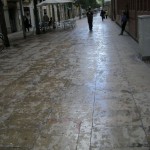
 On 29 May 2009 the Italian team organized a workshop to discuss the progress made in the research and submit the first results of the fieldwork done in each of the districts selected in Barcelona, Athens and Bologna.
On 29 May 2009 the Italian team organized a workshop to discuss the progress made in the research and submit the first results of the fieldwork done in each of the districts selected in Barcelona, Athens and Bologna.
In the first part of the workshop the following technical subjects were discussed:
- Migrants as residents of the place allows us to analyzed their role as creators of scale without recourse to preconceived ideas about weather their relations with the place are determined by nationality or ethnicity.
- Analysis of the (public and private) agents who make up the organization of daily life (e.g. community public social services or health services and immigrants’ associations or “ethnic” businesses)
- Positionality of the gender category with other systems of social inequality and impact on the ways of organizing, acceding to and taking part in public spaces
- Importance of representations of gender and immigration in the design, management and assessment of the urban “integration” and “participation” policies and programmes.
- To explore the connections between public/private, universalism/particularism, equality/difference in the discourses and practices aimed at the integration of immigrants.
In the second part of the workshop, each partner described the characteristics of the district chosen and presented the first results of the fieldwork.
Greece
The case study will take place in the neighbourhood of Kypseli, a neighbourhood where more than 25% of the population are migrants. In this neighbourhood we intend to focus on two interrelated spaces: the central square and the old Market place. The square of Kypseli is a crowded public space where migrant and local people meet and interconnect in various ways. The ‘Agora’ has been squatted two years ago by residents opposing the plans of the municipality to transform it into a commercial centre and is now functioning as a cultural and social centre run by grassroots organizations. Focusing mainly on these two spaces we will try to analyze the intercultural interaction between ‘migrants’ and ‘locals’ and the ways in which this interaction is articulated in urban space.
Italy
Starting from a central neighbourhood (Bolognina), that is the most populous migrant zone in Bologna. Bolognina is not only an area of residence, but also it is a space of relationships and transit of migrants. Bolognina is a sort of “hub” for the migrants: in this way it is particular interesting to analyze the theoretical research questions. Starting from Bolognina, we will try to follow the trajectories and movements of the migrants in the city, illustrating the transformations of the gender relationship, the urban spaces, the citizenship, and the labor market.
Spain
The fieldwork will be done in Poble Sec, a working-class neighbourhood which registered an immigrant population of 27.9%. Pakistanis and Moroccans are the largest groups, followed by a wide variety of other nationalities. However, the most visible section of the population in the use of public space is the Latin American, especially Dominican.
The aim is to focus on Blai St. -a very busy pedestrian and commercial thoroughfare with small shops, a large proportion staffed by immigrants-, and Surtidor Square -where the local Civic Centre provides social and cultural services for migrants and locals alike (including Catalan classes)-, and the Health Centre serves every member of the community. We are also interested in analyzing the new forms of citizenship which are being created by sharing the communal space and applying a gender perspective to all this.
The workshop report is available in PDF or XML format

